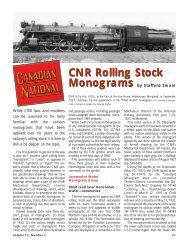CN LINES V12N3 - Canadian National Railways Historical Association
CN LINES V12N3 - Canadian National Railways Historical Association
CN LINES V12N3 - Canadian National Railways Historical Association
Create successful ePaper yourself
Turn your PDF publications into a flip-book with our unique Google optimized e-Paper software.
Wendell Lemon advises that in Extra<br />
2200 South (Issue 49), a short article notes<br />
that the “flutes” of air horns are correctly<br />
termed “bells.” He also suggests that we<br />
should draw attention to some additional<br />
details found in photos in Part One as follows:<br />
“Note the grills on the D-101 (over<br />
the headlights and end windows). The<br />
Newcastle–Fredericton RDC has just<br />
arrived at Fredericton and has bellied up<br />
behind a CPR passenger train. There was<br />
(initially) no pilot on the rear of the<br />
D-100(i) as the other end always led.<br />
However note the single flute (bell) horn<br />
for reverse movements for the conductor<br />
over to South Devon shop. I also see a<br />
steam line hanging to one side. This car<br />
and others had through steam lines for<br />
mixing in with steam-heated trains,<br />
whether diesel- or steam-hauled. The<br />
B&M RDCs also had steam lines when<br />
they came to <strong>CN</strong> in 1965 and 1966. No.<br />
6302 on page 35 must have been going<br />
out as an extra (west from Spadina shops)<br />
as per the white flags. Also note on No.<br />
6004 the add-on tail light for reverse<br />
movements plus the one-bell horn. This<br />
car had steam lines that were cut off at<br />
Moncton. The rear headlight over the<br />
diaphragm on No. 6004 was a permanent<br />
<strong>CN</strong> add-on for back up movements. It<br />
was controlled from another RDC for<br />
leading when MU’ed. The photo on page<br />
39 of No. 6356 is not at Moncton, but<br />
probably at Calder in Edmonton.”<br />
“There was a pile of diaphragms around<br />
the Moncton shop in the Seventies and<br />
then none. They probably went to scrap<br />
when VIA took over the RDCs. The<br />
diaphragms were completely removed<br />
from “A” ends (baggage end) of the 6200s<br />
so the driver could see better. Other<br />
diaphragms were cut down and narrowed<br />
as shown on page 40 of <strong>CN</strong> <strong>LINES</strong><br />
V12N2 with No. 6121. We cut off many<br />
here at Moncton before they went to VIA.<br />
The door chains are on ends of all RDCs,<br />
but many hang in out of sight.”<br />
<strong>Canadian</strong> <strong>National</strong> RDC-3 No. D-350,<br />
ex-D-101(i), operated out of Edmonton for<br />
many years and is pictured circa 1956.<br />
Note the original built-up pilot and triangular<br />
number boards, large end windows, black<br />
“bug board” illuminated number boards on<br />
the letterboard ends, roof exhaust stacks,<br />
dual-bell horn, green-and-yellow ends with<br />
the round monogram, and black lettering on<br />
the letterboard. This represents well the<br />
as-delivered look of Phase One RDCs on the<br />
<strong>CN</strong>R, but by the time of this picture the RPO<br />
section was being used for express.<br />
—George Bergson photo<br />
<strong>CN</strong>R No. D-354 is seen going north out of<br />
Vernon, B.C., in a going-away shot on July<br />
30, 1963. It has been retrofitted with full<br />
pilots at both ends, but still had the single-bell<br />
horn and no triangular number board on the<br />
“B” end. It appears that many <strong>CN</strong> Phase<br />
One RDCs were retrofitted with full pilots at<br />
both ends as the original built-up ones did<br />
not give much protection when rocks or other<br />
larger obstacles were encountered on the<br />
track.— Roger Burrows photo<br />
David Othen adds, “RDC-1 No. 6100<br />
initially had the white <strong>CN</strong> logo on both<br />
the right and left sides of the cab front<br />
above the end sill and the logos were<br />
slightly smaller than those on other units.<br />
Later it was repainted with the conventional<br />
logo on the right.”<br />
At the Shops<br />
The <strong>CN</strong>SIG’s decal set 300-3de is now<br />
available to letter <strong>CN</strong>R 1959-60 era piggyback<br />
trailers (aluminum bodies, see diagram<br />
below) in HO, with or without the<br />
CANADIAN NATIONAL lettering. The set<br />
includes tractor cab-door monograms and<br />
numbers for the 1965 renumbering, along<br />
with detailed instructions. This set is produced<br />
exclusively for the SIG by Ed Barry<br />
of Down East Decals.<br />
4 <strong>CN</strong> <strong>LINES</strong>



